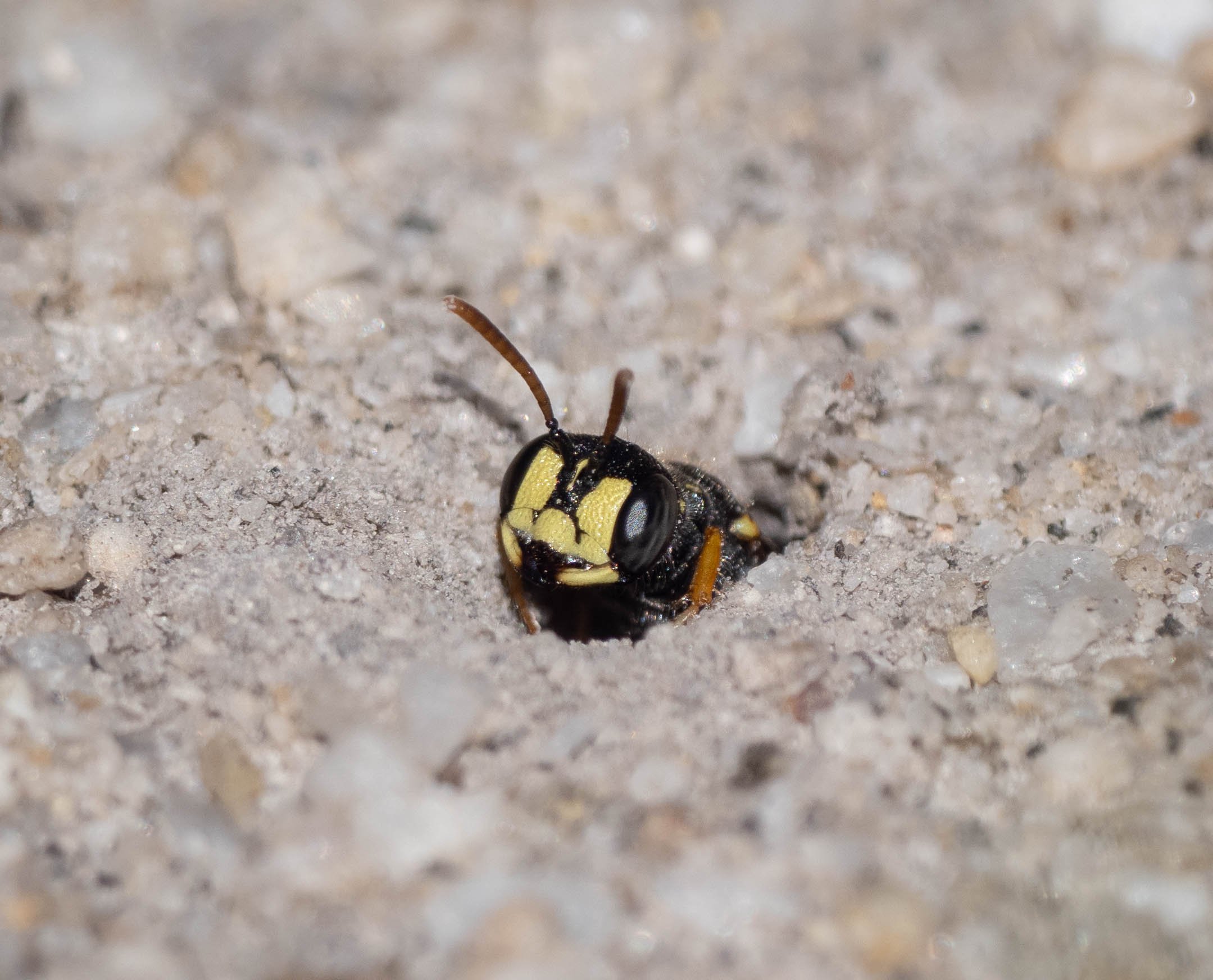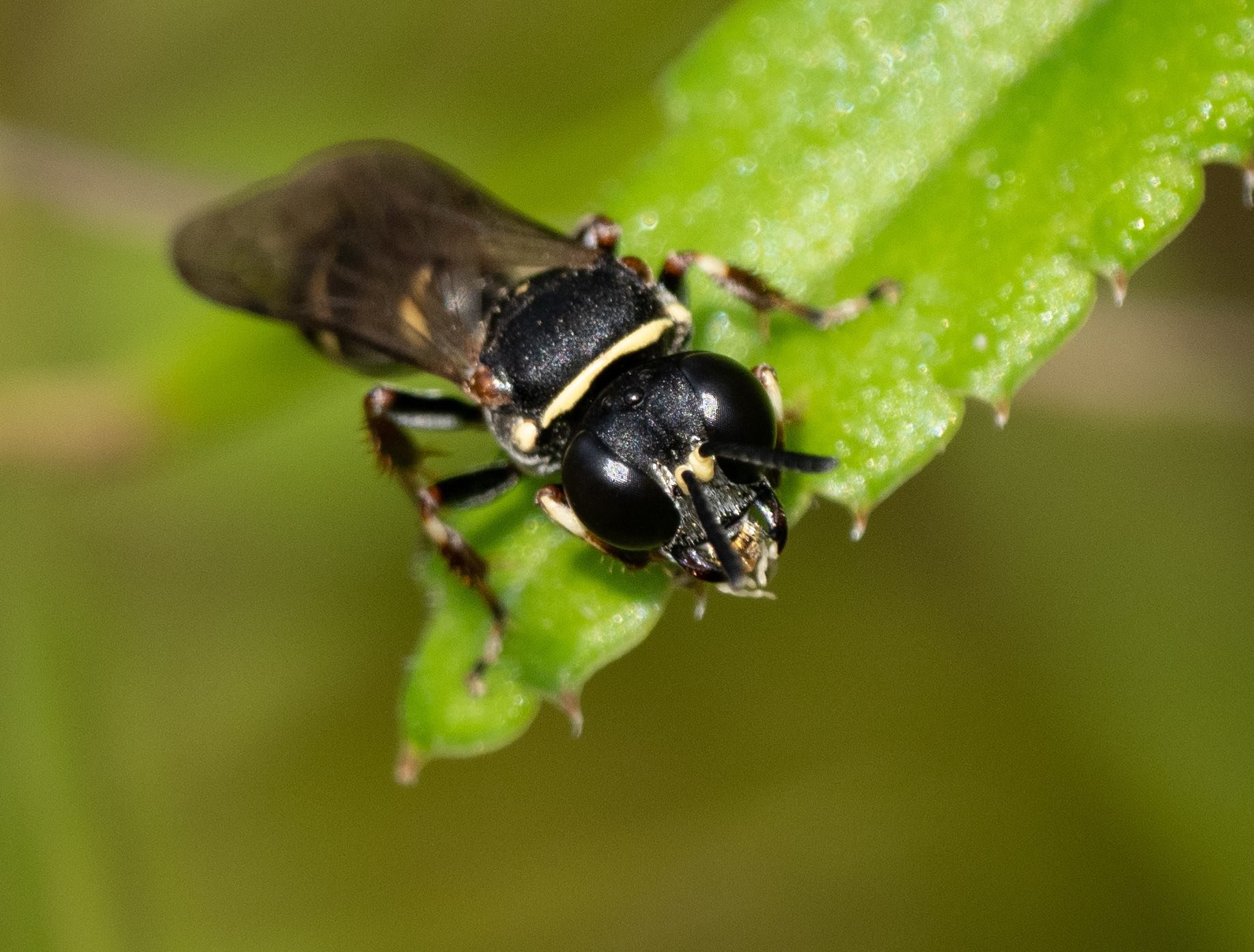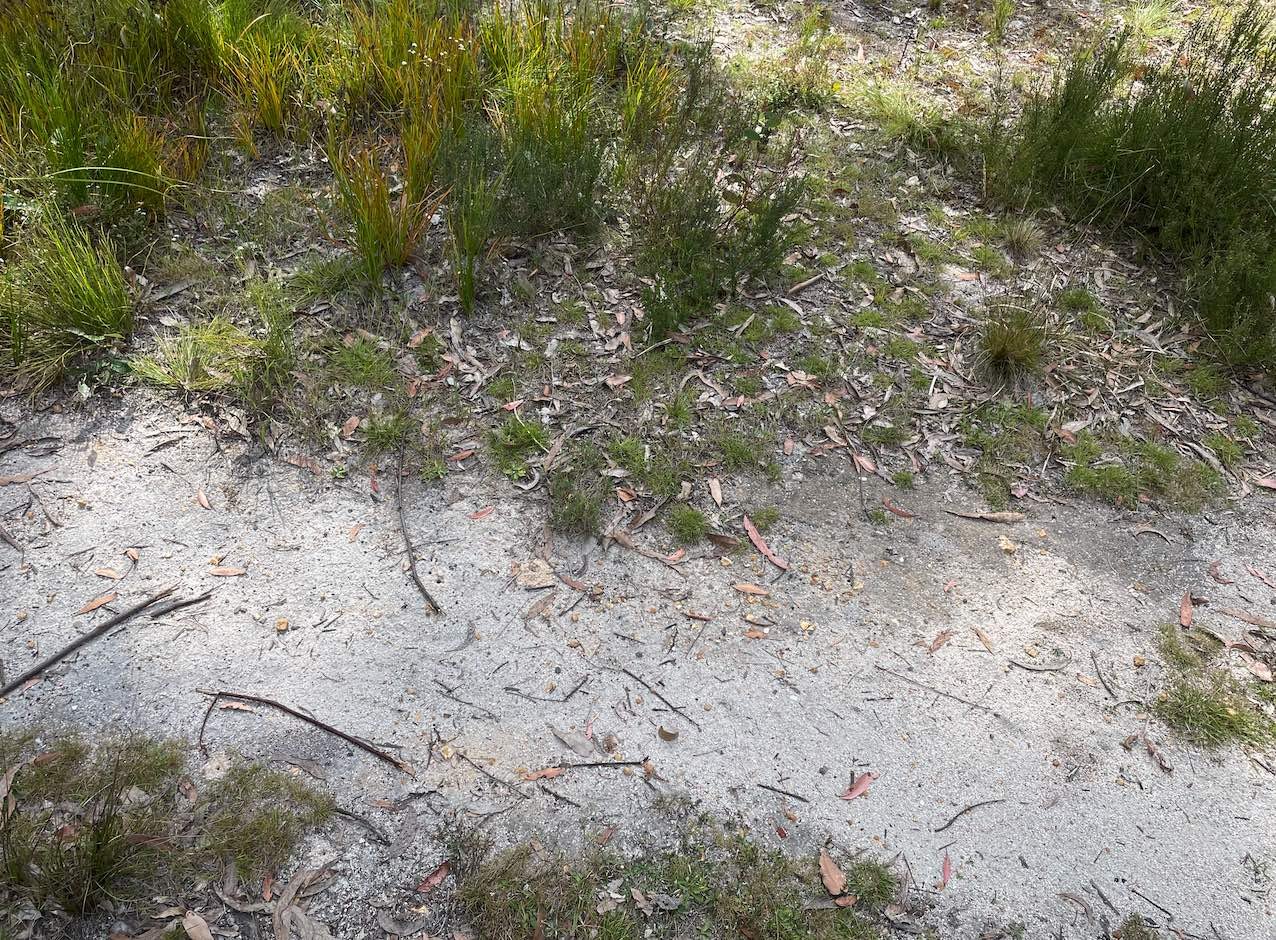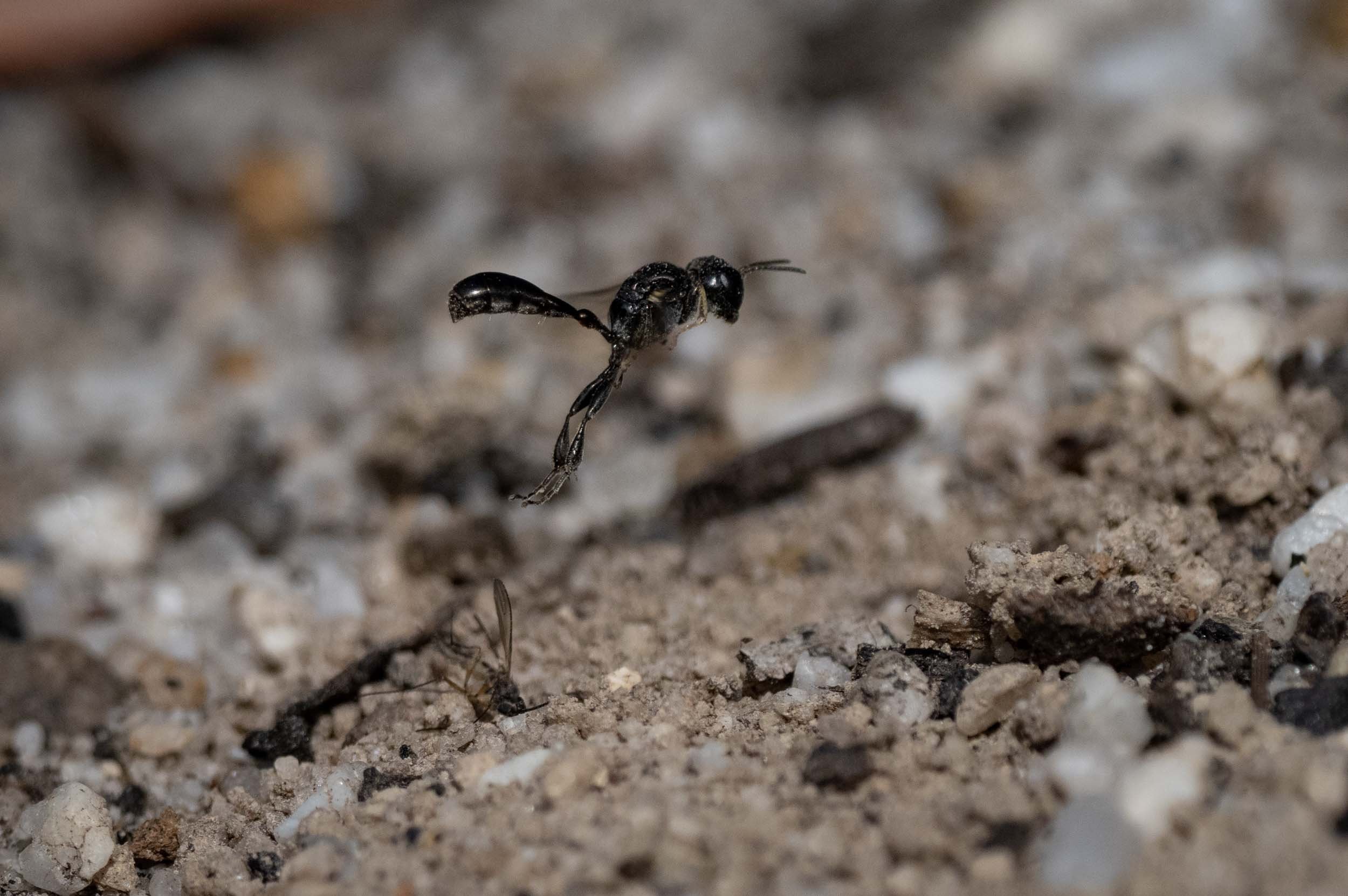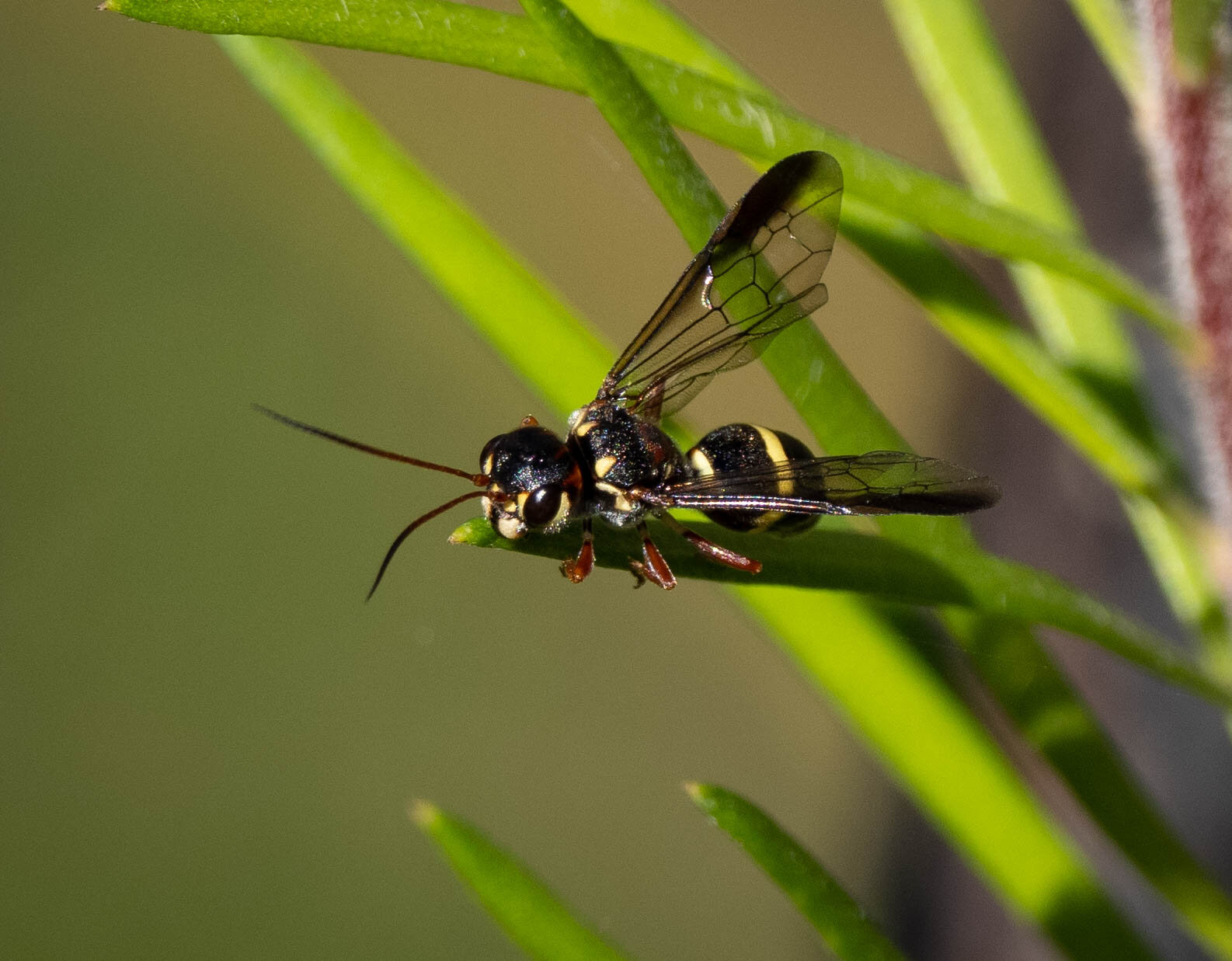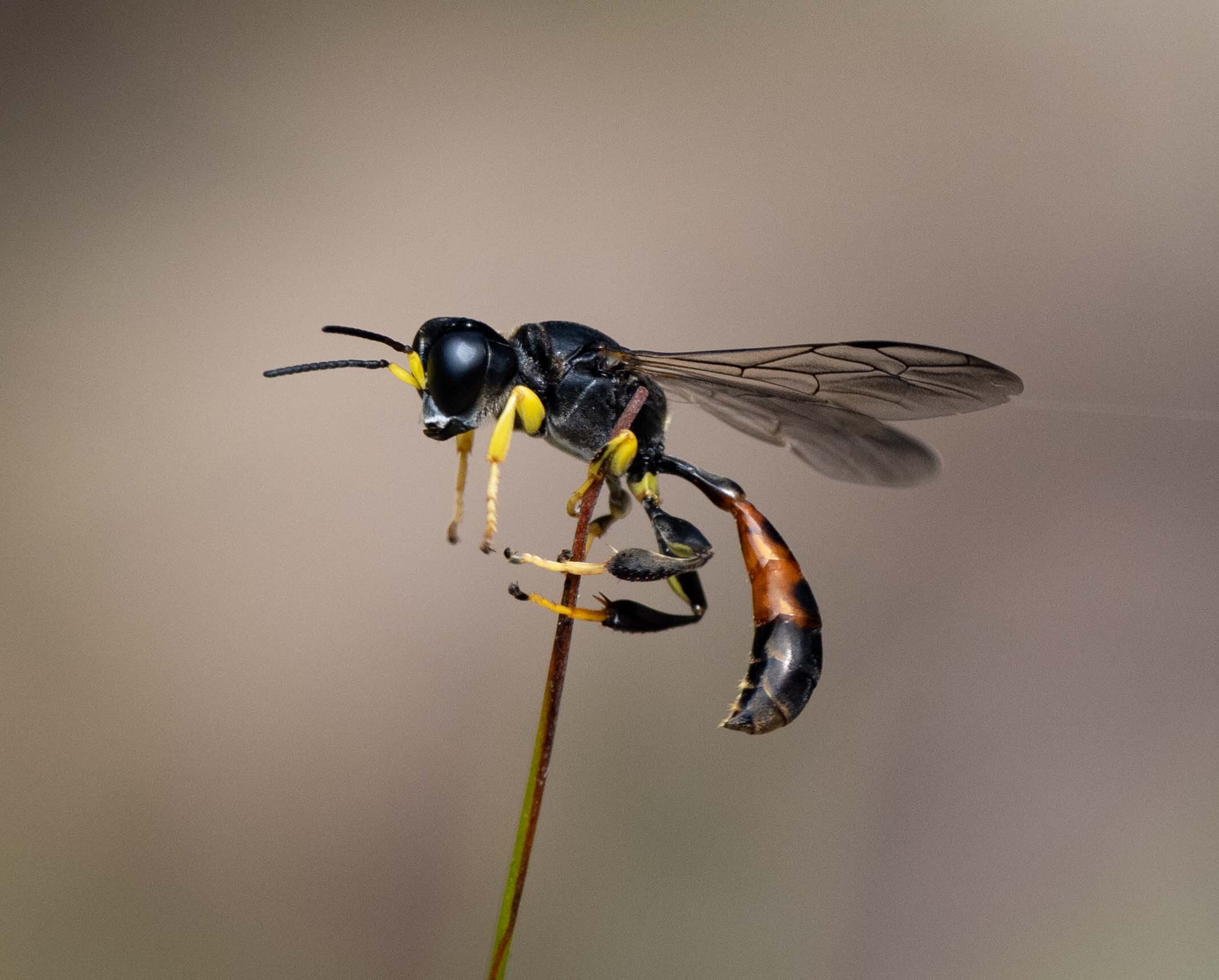More wasp diggings
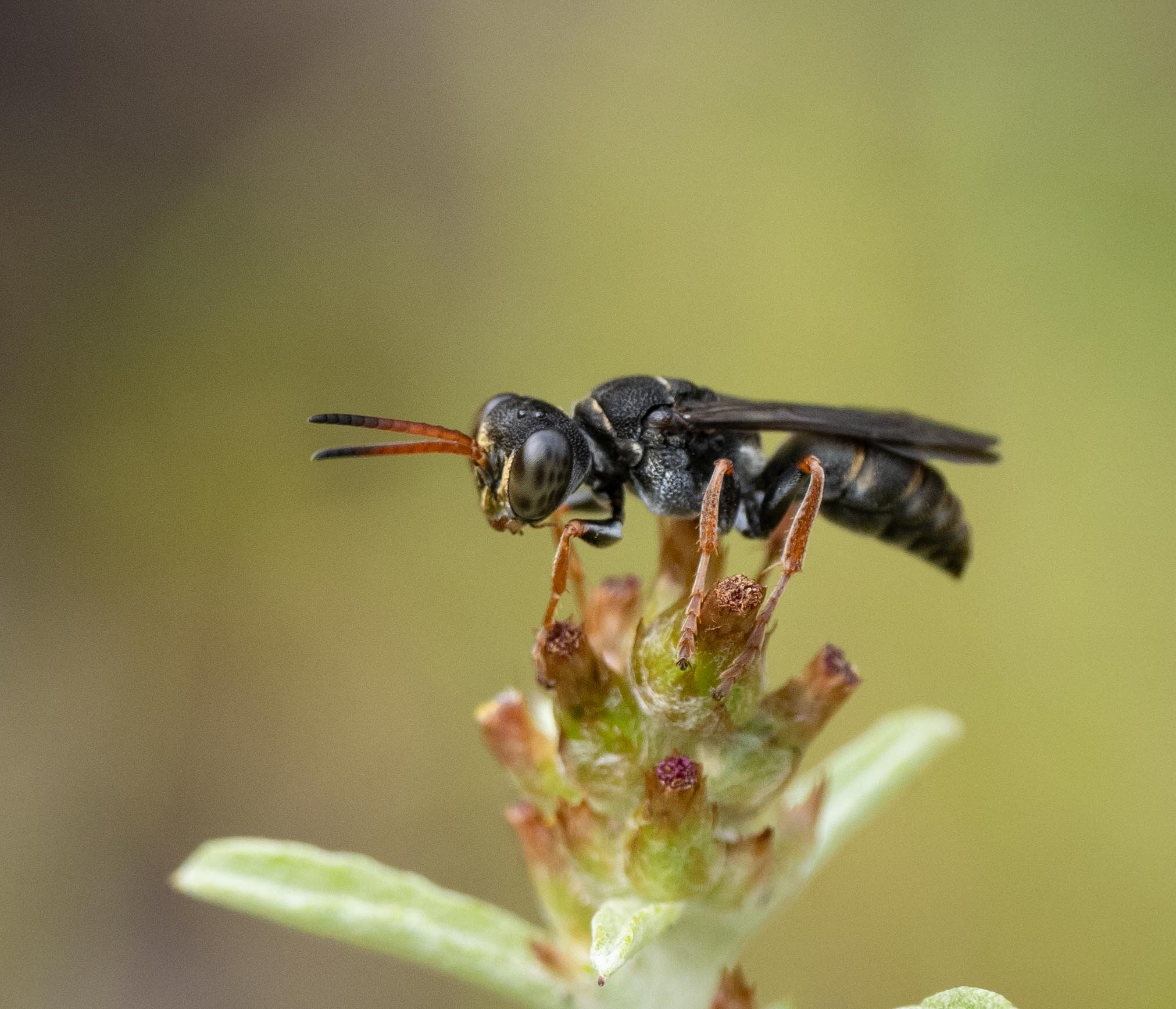
One patch of sandy ground, so many wasps!
I seem to have developed a keen eye for spotting little wasps. This all started in October when I discovered a group of Podagritus nesting in a small patch of sandy ground. Peering intently between grass blades, I watched them for days on end (see my November blog, Digger Wasps).
And now I’ve discovered two more species nesting in the very same patch! Sphodrotes is present in large numbers, alongside a single Gorytina. A short distance away is Bembix territory, and last week I was excited to see a colourful little Cerceris busily hunting amongst the leaf litter.
Life below ground must be getting rather crowded.
First, a bit of background
Many Crabronidae are ground burrowers, including all five species above. There are others that build with mud or wet sand – such as the familar, black Pison wasps (Trypoxylini) that clog garden taps and window frames with rows of spider-packed cells.
Crabronid species differ in their prey choice, covering a wide range of insects and spiders. Females provision each chamber of the nest with paralysed prey before laying an egg and capping the cell. Most Crabronid species are solitary, although nest clustering is common and some species are truly communal.
Published information on the biology of Crabronid species is scant. And there are many, many species. The Australian Faunal Directory currently lists 805 species across 45 genera.
With help from Howard E. Evans
So I’ve been spending rather a lot of time watching and pondering the comings and goings of these ground nesting wasps – Sphodrotes in particular. I’ve also been drawing upon various papers from the 1970s by Howard E. Evans and colleagues.
Evans’ personal history, philosophy and contribution to science is both fascinating and inspirational, his field observations of Australian Crabronidae a treasure. I’ve yet to uncover comparable works, from before his time or since.
I like to think Howard would approve of the hours I spend sitting in the grass with a camera …
Quote from Howard E. Evans’ writings, reprinted many years later in an essay by one of his former students and colleagues, Mary Jane West-Eberhard (2004).
Here’s what I’ve recently observed and learned about two of our local Crabronidae:
Sphodrotes … a square-headed wasp
(Crabroninae; Miscophini)
I first sighted this little wasp at the end of November. It was a perfect photography subject, perched atop a low plant and affording me various views as it pirouetted.
Six weeks on and there are now dozens of individual wasps working this same small patch of ground.
Identification
I am now quite confident that the wasps are Sphodrotes, and that first sighting was a male. For the record, here’s my reasoning.
Appears to be identical to image of Sphodrotes nemoralis in BOLD (link).
Accords with the genus description in Turner’s 1914 review of fossorial hymenoptera, a publication that later authors (i.e. Evans et al.) routinely referenced. In particular, the wing venation … “petiolate second cubital cell”.
The first sighting was a male: males’ antennae have a total of 13 segments, compared to 12 in the female.
The behaviour matches Evans’ 1973 description of nesting Sphodrotes nemoralis in northern Queensland … an open burrow concealed under leaf litter, stocked with shield bugs. But more about that later.
Published sightings are not common. Evans notes that his work in 1973 was the first description of prey and nesting in this endemic Australian genus, and it seems that little has been done since. Even the national biodiversity database, the Atlas of Living Australia (ALA), has just 60 records for Sphodrotes – in stark contrast to its listings for Bembix (>1100) and Cerceris (~500). Images are even rarer. ALA has only five … well six now, counting mine.
This is self justification for including the following (rather large) collection of photos.
Nesting behaviour
Sphodrotes nests are left open and unguarded. But they’re well hidden, quite unlike the obvious sand mound nests of Podagritus. Only by spotting a disappearing female and then removing the leaf litter did I find one. No large sand mound. Just a simple opening within a conical depression.
Thanks to Howard E. Evans’ efforts (1973) I can imagine the burrow structure.
Extract from Evans 1973, page 313 “Sphodrotes nemoralis sp.n. … profile of nest (sections of burrow indicated by dashed lines are hypothetical, as they could not be traced).”
It is likely to be around half a metre deep terminating in a cluster of branches, each leading to a round cell. The cells will be filled with prey, contain a single egg or larva, and closed. Perhaps extra prey lie in the main burrow, stored until the female is ready to make a new cell and lay another egg.
Sphodrotes feed their larvae paralysed shield bugs. The wasps Evans studied were stocking their nests with various species of bugs (Pentatomoidea: shield bugs, stink bugs etc), nearly always nymphs. Our local Sphodrotes are also hunting shield bug nymphs!
I only have two clear sightings of the prey, but in the second of these I got lucky. The laden female spent about 6 minutes perched in the grasses before descending to her burrow. In this time I was able to get quite a good look at her prey and the way she held it – gripping the bug’s antennae with her mandibles and holding it well clear of her body. Quite a small load, in stark contrast to the huge cargoes carried by Podagritus!
Males hang about, ever alert. Now that I’ve worked out how to distinguish the sexes, I realise that most of my sightings are of males. Most females I’ve seen have been returning with prey and I soon lose sight of them among the leaf litter.
These are really quite small insects (~8mm long) and easy to overlook. My impression is that females are a little larger and their face is less golden than the males … but as I’ve only managed to photograph a few in detail, I can’t be sure of this.
The male wasps always seem to be on alert. They scan their surroundings, facing one way and then another.
They fly close to the ground, regularly landing on low vegetation or leaf litter. Their antennae wave in the air, stroke surfaces they contact, and are regularly cleaned. The moment I move, they lock onto me with their huge eyes. Insect vision is not like ours, so I don’t know what they actually see, but they are certainly wary.
Below are more images of more males, all taken around the same patch of ground. There are many males but I’ve yet to see overt contests.
Austrogorytes - an uncommon sand wasp
(Bembicinae; Bembicini; Gorytina)
Amid all the activity of the male Sphodrotes I discovered another, very different nest. It belongs to a sand wasp in the subtribe Gorytina (I describe the species ID process later).
This was a messy, sandy mound in a bare patch amid the grasses. There had clearly been digging going on, but there was no visible entrance. I decided to watch and wait … and was soon rewarded. A strikingly coloured wasp delivering prey – repeatedly.
She was collecting leafhoppers – one after another. Nymphs, adults, and multiple species, always carried in the same way. I saw her make eight deliveries in under 60 minutes, and it’s quite possible that I missed a few!
She was both industrious and focussed. She would fly directly to the mound, dig open the entrance, carry the prey inside and return within seconds. Before flying off she would conceal the opening with sand and gravel. Then she’d take off and disappear from sight.
Most of her time at the nest was actually spent opening and closing the burrow. For example, during one visit that I timed: 24 seconds to open the burrow; 13 seconds spent inside; 21 seconds to cover the opening again, before flying off.
I only saw her around for a few days, and only ever found one nest. But I now realise that I saw a male back in early November. It was unfamiliar at the time, but tentatively identified by an expert on iNaturalist as Gorytina.
It’s a male, and likely to be the same species as my nesting female.
9th Nov, 2020. Male. Gorytina (?)
… see iNaturalist record
Identification
I’m suggesting that these are indeed Gorytina, and therefore probably the genus Austrogorytes. There are few records or ID resources for this group, but I’ve been doing a bit of digging through the literature and it seems a good fit. Largely I’ve drawn on a recent review of the tribe Bembicini (Nemkov & Ohl, 2011) plus descriptions and listings of Australian species. My case is primarily built on the exclusion of other candidates, as the morphological structures used to distinguish Gorytina (see key) are not visible in my photos. At least, not to my eyes.
From the eight genera of Bembicini listed in Australia, I’ve narrowed it down to two: Argogorytes and Austrogorytes. And it’s Howard Evans’ work that I draw upon (again!) in favouring Austrogorytes. Evans and Matthews (1971) observed Austrogorytes bellicosus nesting during Summer, near Canberra. The wasps nested in sandy soil, closed the burrow between visits, and provisioned exclusively with gum leafhoppers (Eurymelidae). And that’s exactly what my female has been doing! Circumstantial evidence, I know, but it fits.
Now just a brief mention of two other Crabronidae nesting nearby.
Bembix - the best-known sand wasp genus
(Bembicinae; Bembicini; Bembicina)
In contrast to the little known, endemic Sphodrotes and Austrogorytes, Bembix are arguably the most widely known and best studied of all the Crabronidae. Hundreds of species, a worldwide distribution, moderately large insects, busy nesting aggregations …. no wonder they’re such a favourite among nature photographers. Yet despite this attention, the life histories of most species remain undocumented (Nemkov & Ohl, 2011).
Every year Bembix colonise sunny, sandy patches of the forest floor. This year there are perhaps fewer than usual, but they are here. Species ID? Yet to be determined, and there may well be more than one.
Bembix nests are another example of closed doors. Fly in hand, she has to excavate the opening each time. And before departure she laboriously fills it again with bits of gravel and sand. Once she’s done, the burrow is completely concealed. No tell-tale mound, depression or scrape marks.
Cerceris – a beetle hunter
(Philanthinae; Cercerini)
Although I haven’t yet found their nests, I’m confident these little wasps are breeding nearby. I’ve seen a female searching about in the leaf litter, no doubt hunting small beetles for her young. And more recently I spotted a male, feeding at flowers.
I’ve watched Cerceris nest here in past years and our local species seems to prey on small, shiny beetles. Several wasps appear to share a burrow, with one on guard duty throughout the day while others hunt. And they close the door at night.
I’m keeping an eye out for disturbed sand patches … I think they’ll be nesting somewhere close.
I find it extraordinary to think of the drama and elegance of wasps’ lives, playing out unnoticed beneath our feet. Howard E. Evans expressed similar sentiments, but much more eloquently …
Quote from Howard E. Evans’ writings, reprinted many years later in an essay by one of his former students and colleagues, Mary Jane West-Eberhard (2004).
References
Bohart, R.M. 1967. New genera of Gorytini (Hymenoptera: Sphecidae: Nyssoninae). The Pan-Pacific Entomologist, 43: 155-161
Evans, H.E. 1973. Observations on the nests and prey of Sphodrotes nemoralis sp. n. (Hymenoptera: Sphecidae). Australian Entomological Society, 12: 311-314 (link)
Evans, H.E. 2002. A review of prey choice in bembicine sand wasps (Hymenoptera: Sphecidae). Neotropical Entomology, 31(1): 1-11
Evans, H.E. & Matthews, R.W. 1970. Notes on the nests and prey of Australian wasps of the genus Cerceris (Hymenoptera: Sphecidae). Journal of the Australian Entomological Society, 9: 153-156
Evans, H.E. & Matthews, R.W. 1971. Nesting behaviour and larval stages of some Australian Nyssonine sand wasps (Hymenoptera: Sphecidae). Australian Journal of Zoology, 19: 293-310.
Matthews, R.W. & Evans, H.E. 1971. Biological notes on two species of Sericophorus (Hymenoptera: Sphecidae). Psyche, (1971): 413-429
Nemkov, P.G. & Lelej, A.S. 1996. Phylogenetic relationships and classification of the digger wasps tribe Gorytini (Hymenoptera: Sphecidae, Nyssoninae). Far Eastern Entomologist, 37: 1-14
Nemkov, P.G. & Ohl, M. 2011. A cladistic analysis and reclassification of the tribe Bembicini (Hymenoptera: Crabronidae: Bembicinae). Zootaxa, 2801: 27-47
Pulawski, W.J. 2012. A review of the genus Larrisson Menke, 1967, and description of the new genus Larrissa (Hymenoptera, Crabronidae). Journal of Hymenoptera Research, 25: 35-82
Turner, R.E. 1914. Notes on fossorial hymenoptera. XIII. A revision of the Paranyssoninae. The Annals and Magazine of Natural History. 8(14): 337-359
West-Eberhard, M.J. 2004. Howard E. Evans: Known and little-known aspects of his life on the planet. Journal of the Kansas Entomological Society, 77(4): 296-322 (pdf)
Note regarding identifications
Despite our best efforts, we often overlook something when trying to identify insects. Happily, there are more knowledgeable people out there and we can learn from them. I’ve put several of the photos above onto iNaturalist. If you want to check for any species ID updates, please use the iNaturalist records listed below:
Sphodrotes (male; male; female)
Gorytina / Austrogorytes (male; female)
Bembix (female)
































































